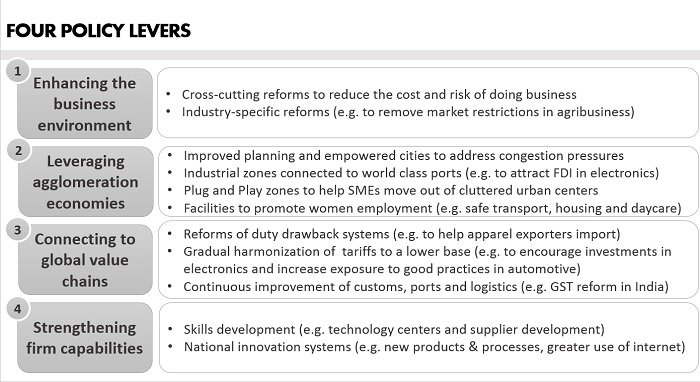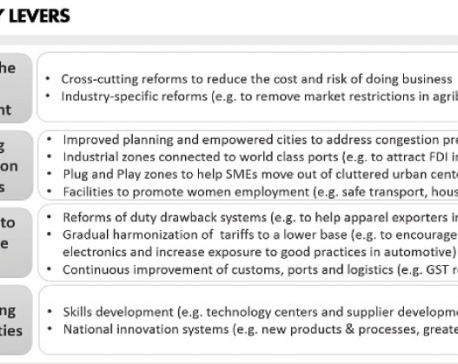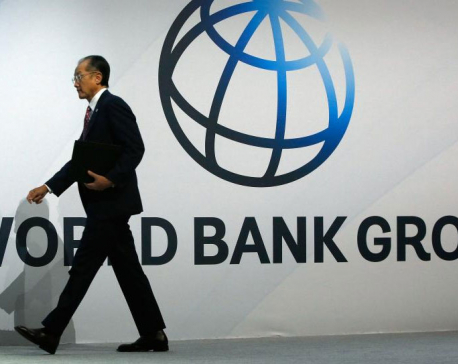
OR
WB report recommends four ‘policy levers’ to boost productivity, competitiveness of South Asia
Published On: October 7, 2016 10:44 AM NPT By: Sagar Ghimire | @sagarghi
WASHINGTON DC, Oct 7: South Asia can become the next manufacturing and export powerhouse if it increases the competitiveness, according to a new report by the World Bank.
The new report entitled ‘South Asia’s Turn, Policies to Boost Competitiveness and Create the Next Export Powerhouse’, released on Thursday also underlines a right mix of reforms and investments to boost the competitiveness and productivity.
Speaking at a discussion, ‘How Can South Asia's Firms Better Compete?’ on Thursday on the sidelines of 2016 Annual Meetings of International Monetary Fund and World Bank Group in Washington DC, trade experts, World Bank Group’s senior officials, researchers and policy makers said that South Asian countries have underperformed in terms of both the quantity and quality of exports because most firms in the region have low productivity, which is the main driver of sustained competitiveness.
“South Asia seems to be less competitive than its neighbors. Little progress has been made in diversifying exports and converting them into higher value added products in the region,” said Anabel Gonzalez, Senior Director, Trade and Competitiveness at World Bank Group.
“Countries in the region still need to build more competitive business environment, increase productivity and capitalize the benefits of urbanization and clusters,” she added.
According to the speakers at the discussion, the region’s policymakers should reexamine the contents and prioritization of the policy toolkit when it comes to competitiveness and productivity.
They say the region can compete in the global scale and realize its enormous potential if it can put in place needful ‘policy levers’, they say.
Speaking at the event, Kim Elliot, Senior Fellow, Center for Global Development, said that there should be also priority in integrating small and land-locked countries in the region as a part driving competitiveness.
“There are three large economies—Bangladesh, India and Pakistan— in the region who do have pretty good access in terms of transportation and proximity to market. There are also small land-locked countries like Nepal, Bhutan and Afghanistan,” she said. “It should also be figured out how to better integrate those smaller economies regionally,” she added.
Rubana Huq, Managing Director, Mohammadi Group, Bangladesh, highlighted the need of competitiveness of private firms in terms of price, quality, productivity and compliance to boost their productivity.
The authors, in their report, have outlined four ‘policy levers’ that can help the region become more globally competitive across a broader spectrum of industries, accelerating growth and reducing poverty, especially for women.
So what are the four policy levers recommended in the report?

The report calls for enhancing business environment, leveraging agglomeration economies, connecting to global value chains and strengthening firm capabilities as the levers that can boost competitiveness and productivity in the region.
While enhancing business environment has been always featuring in the policy discourse and policy pathways to address them have been mapped out by various institutions, the remaining three levers are new and less prominent in discussions related to trade competitiveness of South Asia, according to authors of the report.
The authors have analyzed agribusiness, electronics, apparel and automotive as case studies to find out the drivers and constraints to productivity.
You May Like This

Four policy levers recommended to boost S Asia’s competitiveness
WASHINGTON, Oct 7: South Asia can become the next manufacturing and export powerhouse if it increases the competitiveness, according to a... Read More...

South Asia ranks second in global growth: WB
KATHMANDU, Oct 8: After leading global growth for two years, the countries of South Asia have fallen to the second place... Read More...

Failure to criminalize enforced disappearance major obstacle to justice in South Asia: New ICJ report
KATHMANDU, August 30: South Asian states can only address the tens of thousands of cases of enforced disappearances by recognizing... Read More...





Just In
- MoHP cautions docs working in govt hospitals not to work in private ones
- Over 400,000 tourists visited Mustang by road last year
- 19 hydropower projects to be showcased at investment summit
- Global oil and gold prices surge as Israel retaliates against Iran
- Sajha Yatayat cancels CEO appointment process for lack of candidates
- Govt padlocks Nepal Scouts’ property illegally occupied by NC lawmaker Deepak Khadka
- FWEAN meets with President Paudel to solicit support for women entrepreneurship
- Koshi provincial assembly passes resolution motion calling for special session by majority votes






_20220508065243.jpg)






Leave A Comment